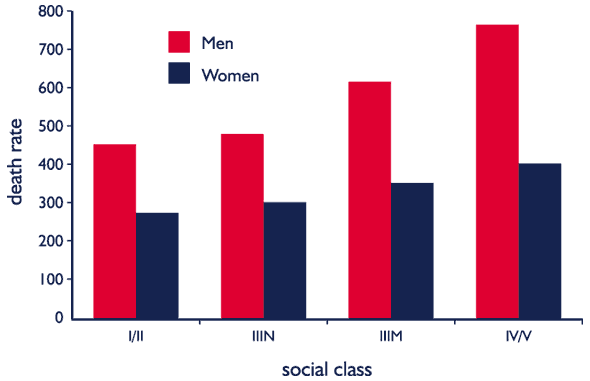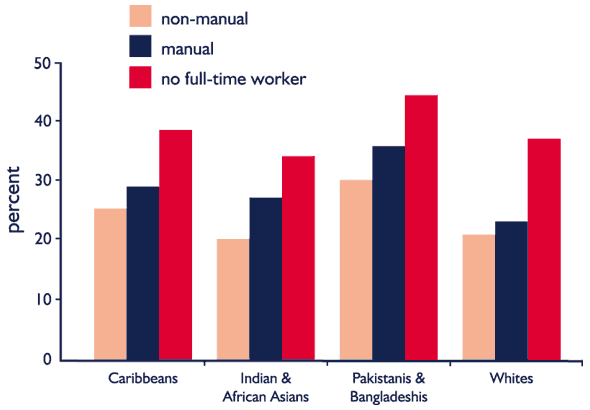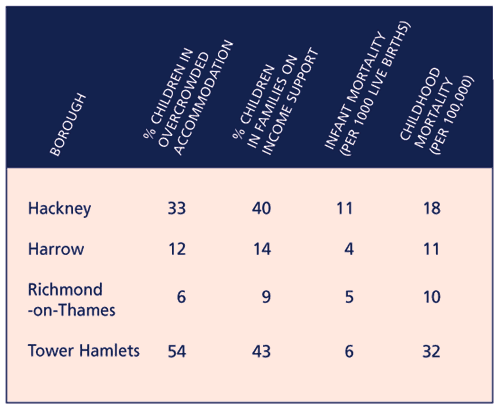 |
Close
window to return
|
Issue 6, July 2000, pp.2-3.
Reports from the Programme conference
Introduction
Hilary Graham
Health is a basic
liberty, fundamental to participation inn the society to which one belongs.(1)
It is a liberty which is unequally distributed. Those on the higher rungs
of the socio-economic ladder are more likely to survive in good health;
those on the lower rungs are more likely to succumb to disease and premature
death. In the UK, socio-economic gradients in health and mortality are
evident for both men and women and across ethnic groups (see Figures 1
and 2).(2,3) The evidence also points to widening health inequalities,
as deaths from major diseases like heart disease and cancer fall more
rapidly in higher than lower socio-economic groups.
Figure 1: Age standardised death rates per 100,000 people by social
class, men and women aged
35-64, England and Wales, 1986-92

Note: Women are classified by partner's occupational details or, if
absent, by their own
Source: Harding et al 1997 (2)
Figure 2: Reported fair or poor health by social class

Source: Nazroo, 1997 (3)
Inequalities between individuals are matched by inequalities between
places, with premature deaths concentrated in poor areas. These spatial
inequalities in health are also increasing, as poorer areas lose out in
the general improvement in health. Research conducted under the Health
Variations Programme demonstrates that these geographical inequalities
'now stand at their highest ever recorded.' (4)
These trends have emerged against a backdrop of increasing national prosperity
- and increasing social polarisation. Economic growth has been achieved
at the cost of a rapid decline in the manual jobs which were the backbone
of working class communities. It has been accompanied, too, by a tax and
benefit system which has failed to protect the living standards of poorer
households. The result has been a sharp rise in poverty and income inequality,
together with a spatial concentration of social disadvantage and economic
decline. Table 1 captures this spatial patterning of disadvantage among
children in London and the associated concentrations of poor health. (5,6)
As the government acknowledges, tackling health inequalities requires
policies which address these broader social inequalities. Such policies
turn on an understanding of the processes and pathways which link them.
A single pathway would, of course, simplify the explanatory task and provide
a clear steer for policy. However, the evidence points to multiple chains
of risk, running from the broader social structure through living and
working conditions to health-related habits like diet and cigarette smoking.
Methodological advances are enabling researchers to track how these chains
of risk run across peoples' lives and through factors operating at individual,
household and area level. Researchers in the Health Variations Programme
have been working to extend and deepen these important lines of enquiry.
The Programme conference in June 2000 provided an opportunity to present
findings to those vested with the task of taking forward the new public
health strategies, both in and beyond the UK.
Table 1: Child need and child health: examples from London boroughs
(1997)

Source: Health
of Londoners Project, 1995, London Research Centre, 2000 (6)
The conference was organised around a series of linked presentations,
drawing on qualitative and quantitative projects in the Programme.
The presentations drew on findings from:
- research which had tracked how risks, and their health-damaging consequences, accumulate across the lifecourse. Drawing on longitudinal data, projects have demonstrated that disadvantage in infancy, adolescence and early adulthood all make a contribution to poor health in adulthood. Other projects have focused on how people understand the legacy of the past and the way these understandings affect current health beliefs and health behaviours (see the synopses of the presentations by Chris Power and Kate Hunt, Health Variations Programme Newsletter, Issue 6, p.4).
- projects which are examining the influence of areas and places. These confirm that area and regional inequalities in health reflect the different socio-economic composition of areas of low and high mortality. But these projects suggest that areas also have an effect. Economic decline, poor local services and low social cohesion are among the factors identified by researchers in the Health Variations Programme (see the synopses of the presentations by Heather Joshi and Carol Thomas, Health Variations Programme Newsletter, Issue 6, p.5).
- a third set of projects are concerned with the intersections between ethnicity, gender and socio-economic status. Research has explored, for example, how employment opportunities and housing careers can be disrupted by migration and constrained by racism. It has examined, too, how different dimensions of socio-economic inequality - like employment conditions and material living standards - have different roles to play in the socio-economic patterning of women's health (see the synopses of the presentations by George Davey Smith and Mel Bartley, Health Variations Programme Newsletter, Issue 6, p.6).
- As a final example, the Programme conference presented findings concerned with the impact of policy, at national and international level. Drawing on a project undertaken in collaboration with Swedish researchers, Margaret Whitehead presented a framework through which to map the health inequalities impact of policies (see the synopsis of the presentation by Margaret Whitehead, Health Variations Programme Newsletter, Issue 6, p.7).
Tackling health inequalities
requires, of course, more than an understanding of their causes. But it
is an essential first stage for a public health strategy committed to
ensuring that health is a basic liberty for all.
References:
1. Sen, A. (1999) Development as Freedom, Oxford : Oxford University
Press.
2. Harding, S., Bethune, A., Maxwell, R. and Brown, J. (1997) 'Mortality
trends using the longitudinal study' in F. Drever and M. Whitehead (eds.)
Health Inequalities series DS No. 15, London : The Stationery Office.
3. Nazroo, J. (1997) The Health of Britain's Ethnic Minorities: Findings
from a National Survey, London : Policy Studies Institute.
4. Dorling, D., Shaw, M. and Brimblecombe, N. (2000) 'Housing wealth and
community health: exploring the role of migration' in H. Graham (ed.)
Understanding Health Inequalities, Buckingham : Open University
Press.
5. Health for Londoners Project (1999) Child Health in London,
London : East London and the City Health Authority.
6. London Research Centre (2000) Getting the Benefit: A Study of Social
Security Receipt in London, London : London Research Centre.